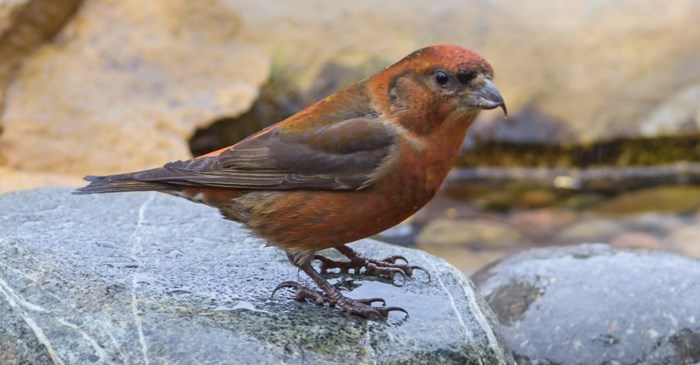If loud, anxious chattering from high above interrupts your peaceful walk in the woods this winter… look up! You might be thrilled to catch a roving flock of Red Crossbills ravenously extracting every last seed from the cones at the top of an evergreen tree. These plump finches are famous for their extraordinary bills with a sickle-like top mandible that crosses the bottom like a pair of busted scissors.
In North America, Red Crossbills occur in coniferous forests from Alaska to eastern Canada and the northeastern United States, with the biggest populations concentrated in the coastal and mountain forests of the Pacific Northwest and the Rockies. Unlike most birds in temperate areas, Red Crossbills have two breeding seasons in a calendar year. The first is in late summer, right when cone crops are ripening. The second breeding cycle comes after cones have matured. From winter through spring, crossbill flocks from a dozen to several hundred birds roam the landscape looking for a food supply of evergreen cones that can support a second round of nesting.Thanks in part to the drought of 2016 and wet spring of 2017, this winter the spruces, hemlocks, pines, and other conifer trees across parts of the Midwest and Northeast are bursting with the biggest cone crop in decades. At the same time, conifer crops across the mountainous West and much of the western boreal forest—the typical winter haunts for most crossbills—are failing. According to Matt Young, of the Cornell Lab of Ornithology’s Macaulay Library, the conditions are brewing for a major irruption of Red Crossbills this winter. “Red Crossbills are on the move,” says Young, “and this year’s movement is shaping up to be the most impressive in recent history.”
And when the cone crops fail in the West, hordes of hungry crossbills come east looking for food.
The last major Red Crossbill irruption was during the winter of 2012–13. Based on early observations, this winter is shaping up to be even more spectacular. Observers in the upper Midwest saw an unusually large number of crossbills this past summer. In late October, an observer at Stony Point, Minnesota, counted nearly 1,100 Red Crossbills moving south along the shore of Lake Superior, an all-time high count for the state according to eBird.org.
Red Crossbill numbers were also well above average in Maine, Vermont, New Hampshire, and northern New York, where evergreen forests typically host a modest breeding population in summer.
And because of that second breeding cycle for Red Crossbills, Young says the irruption may not end when the snow melts.
“This event should carry on right into the spring,” he says. “Crossbills should be breeding in many areas between January and April.”
